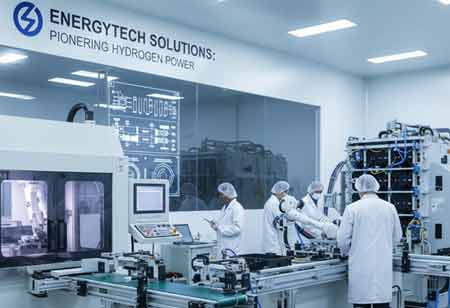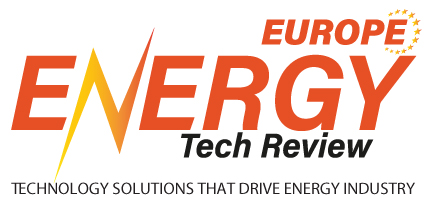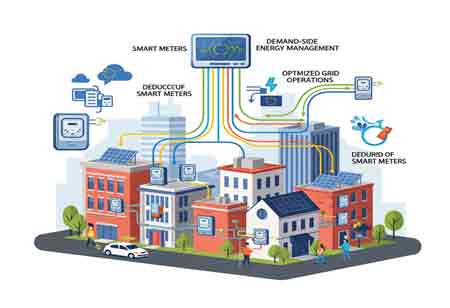CLOSE
Specials
I agree We use cookies on this website to enhance your user experience. By clicking any link on this page you are giving your consent for us to set cookies. More info
Be first to read the latest tech news, Industry Leader's Insights, and CIO interviews of medium and large enterprises exclusively from Energy Tech Review
Thank you for Subscribing
Industrialising Hydrogen: Capitalising on Europe's Flow Plate Supply Chain
Europe's shift to mass manufacturing for hydrogen technology centres on bipolar flow plates, advancing precision and efficiency through high-speed forming and surface engineering, crucial for gig

By
Energy Tech Review | Monday, November 24, 2025
Stay ahead of the industry with exclusive feature stories on the top companies, expert insights and the latest news delivered straight to your inbox. Subscribe today.
As Europe accelerates toward a decarbonised future, the continent is witnessing an unprecedented shift from prototype laboratories to industrial-scale gigafactories. While the headlines often focus on the broader implementation of green hydrogen or the total gigawatt capacity of new projects, a quiet but decisive revolution is occurring within the supply chain. At the heart of this industrialisation lies a singular, sophisticated component: the bipolar flow plate.
The transition from boutique production to mass manufacturing of electrolysers and fuel cells is fundamentally a story of manufacturing precision. As European industry scales up, flow plate manufacturers are moving from the periphery to the centre of the value chain, becoming the critical enablers of the hydrogen economy. These components, which orchestrate the movement of gases, electrons, and heat within the stack, are no longer just parts; they are the defining variable in the speed, efficiency, and scalability of the continent's new energy infrastructure.
The Architecture of Scale: From Machining to High-Speed Forming
In the early stages of hydrogen technology development, flow plates were predominantly machined from graphite composites—a slow, subtractive process suitable for low volumes but ill-suited for the demands of a gigafactory. The current state of the industry is defined by a decisive pivot toward metallic plates and high-speed forming technologies, enabling production rates that align with automotive-style assembly lines.
The physics of mass production drives this transition. Modern gigafactories require millions of plates annually to meet gigawatt-scale targets. Consequently, the industry has adopted advanced hydroforming and progressive stamping techniques. These methods allow manufacturers to shape ultra-thin stainless steel or titanium foils—often just a fraction of a millimetre thick—into complex channel geometries with micron-level precision.
The industrialisation of these forming processes represents a triumph of mechanical engineering. By utilising high-tonnage presses and precision tooling, manufacturers can now produce plates in cycles measured in seconds rather than minutes. This "heartbeat" of production is critical; it ensures that the supply of plates creates a synchronous rhythm with the automated stacking processes of the final assembly. The move to metallic forming enables thinner, lighter, and more power-dense stacks, thereby directly enhancing the volumetric efficiency of final electrolyser or fuel cell systems. The industry is currently optimising these lines for continuous operation, ensuring that the plate's physical architecture supports not only the electrochemical reaction but also the economic logic of mass manufacturing.
Surface Engineering as a Driver of Longevity and Efficiency
While the physical shape of the flow plate facilitates the distribution of hydrogen and oxygen, it is the surface engineering that guarantees performance over the lifespan of the system. The state of the industry today places immense value on advanced coating technologies, which have become a distinct and vital sub-sector of the hydrogen ecosystem. As raw metal plates are susceptible to the harsh, corrosive environments inside an electrolyser or fuel cell, the industrialisation of coating processes has become as crucial as the forming of the plates themselves.
Europe’s manufacturing sector is currently standardising high-throughput Physical Vapour Deposition (PVD) and continuous coil coating processes. The focus is on creating multi-functional surfaces that simultaneously prevent corrosion, minimise contact resistance, and maintain high electrical conductivity. Innovation here is moving away from batch-coating individual plates toward continuous "roll-to-roll" processing. In this paradigm, the metal strip is coated with specialised carbon-based or precious metal-free layers before it is even stamped or formed.
This evolution in surface engineering is integral to the concept of the gigafactory. By integrating coating into the upstream material supply, manufacturers drastically reduce the handling time and logistical complexity on the assembly floor. The result is a streamlined flow where surface properties are engineered at the atomic level but applied at the industrial scale. This capability ensures that the resulting stacks meet the rigorous durability requirements of heavy-duty transport and continuous industrial electrolysis, securing the asset value of the green hydrogen infrastructure.
Integration and Automation: The Smart Factory Approach
The third pillar of this industrial transformation is the complete integration of flow plate manufacturing into the digital and physical fabric of the gigafactory. The industry is moving beyond viewing the flow plate as a sourced commodity and is now treating it as an integrated step in a smart manufacturing ecosystem. This trend is characterised by the adoption of Industry 4.0 principles, where data, automation, and laser welding technologies converge.
Modern flow plate production lines are becoming autonomous islands of high-tech assembly. The joining of anode and cathode plates—often achieved through high-speed remote laser welding—is now coupled with real-time, inline quality assurance. Advanced optical inspection systems and leak-testing algorithms scan every millimetre of the weld seam and channel geometry without slowing down the line. This digitisation of quality control creates a "digital twin" for every plate produced, ensuring total traceability from the raw coil to the finished stack.
The spatial dynamics of manufacturing are changing. There is a growing trend toward co-location, where flow plate manufacturing lines are installed directly adjacent to, or inside, the electrolyser and fuel cell gigafactories. This vertical integration minimises logistics, reduces inventory-holding costs, and enables rapid feedback loops between stack designers and plate manufacturers. It signifies a mature industrial approach in which the boundaries between component suppliers and system integrators blur, creating a cohesive, highly efficient production organism capable of meeting Europe’s ambitious energy goals.
The industrialisation of Europe’s hydrogen economy is a testament to the continent’s engineering heritage, yet it is driven by a new imperative: speed and scale. While the electrolyser and the fuel cell are the engines of this transition, the flow plate manufacturers are the architects of its feasibility. Through mastery of high-speed forming, advancement in nanoscale surface engineering, and the implementation of fully automated, data-driven production lines, this sector has positioned itself as the keystone of the hydrogen value chain. As gigafactories continue to rise across the continent, the precision and volume capabilities of flow plate manufacturing will remain the fundamental metrics by which the success of the hydrogen revolution is measured.

Copyright © 2025 Energy Tech Review. All rights reserved






